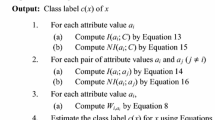Abstract
In this article, a filter feature weighting technique for attribute selection in classification problems is proposed (LIA). It has two main characteristics. First, unlike feature weighting methods, it is able to consider attribute interactions in the weighting process, rather than only evaluating single features. Attribute subsets are evaluated by projecting instances into a grid defined by attributes in the subset. Then, the joint relevance of the subset is computed by measuring the information present in the cells of the grid. The final weight for each attribute is computed by taking into account its performance in each of the grids it participates. Second, many real problems contain low signal-to-noise ratios, due to instance of high noise levels, class overlap, class imbalance, or small training samples. LIA computes reliable local information for each of the cells by estimating the number of target class instances not due to chance, given a confidence value. In order to study its properties, LIA has been evaluated with a collection of 18 real datasets and compared to two feature weighting methods (Chi-Squared and ReliefF) and a subset feature selection algorithm (CFS). Results show that the method is significantly better in many cases, and never significantly worse. LIA has also been tested with different grid dimensions (1, 2, and 3). The method works best when evaluating attribute subsets larger than 1, hence showing the usefulness of considering attribute interactions.





Similar content being viewed by others
Notes
Specifically, p r o b B (X ≤ c e l l.C 1) = c o n f i d e n c e. This will be explained in more detail in the next paragraphs.
The GSL library has been used for computing CDFBINOM: https://www.gnu.org/software/gsl
Technically, this is done for all cells, but also, all cell groupings, or hiper-cells, with a paralelepide (rectangular-like) shape. The reason is that in some cases, the region that contains the information is larger than a single cell.
I R is the ratio between the number of instances of the majority class vs. the minority class.
References
Alcalá-Fdez J, Fernández A, Luengo J, Derrac J, García S, Sánchez L, Herrera F (2011) Keel data-mining software tool: Data set repository, integration of algorithms and experimental analysis framework. Journal of Multiple-Valued Logic & Soft Computing, 17
Asuncion A, Newman D (2007) Uci machine learning repository
Ben-Bassat M (1982) Pattern recognition and reduction of dimensionality. Handb Stat 2:773–910
Bennasar M, Hicks Y, Setchi R (2015) Feature selection using joint mutual information maximisation. Expert Syst Appl 42(22):8520–8532
Das S (2001) Filters, wrappers and a boosting-based hybrid for feature selection ICML, vol 1. Citeseer, pp 74–81
Demšar J (2006) Statistical comparisons of classifiers over multiple data sets. J Mach Learn Res 7:1–30
Forman G (2003) An extensive empirical study of feature selection metrics for text classification. J Mach Learn Res 3:1289– 1305
Guyon I, Elisseeff A (2003) An introduction to variable and feature selection. J Mach Learn Res 3:1157–1182
Hall M, Frank E, Holmes G, Pfahringer B, Reutemann P, Witten IH (2009) The weka data mining software: an update. ACM SIGKDD Explorations Newsl 11(1):10–18
Hall MA (1999) Correlation-based feature selection for machine learning. PhD thesis, The University of Waikato
Hall MA, Smith LA (1997) Feature subset selection: a correlation based filter approach International conference on neural information processing and intelligent information systems, pp 855–858
Inza I, Larrañaga P, Blanco R, Cerrolaza AJ (2004) Filter versus wrapper gene selection approaches in dna microarray domains. Artif Intell Med 31(2):91–103
Karegowda AG, Manjunath AS, Jayaram MA (2010) Comparative study of attribute selection using gain ratio and correlation based feature selection. Int J Inform Technol Knowl Manag 2(2):271–277
Kira K, Rendell LA (1992) The feature selection problem: Traditional methods and a new algorithm AAAI, pp 129– 134
Kohavi R, John GH (1998) The wrapper approach Feature extraction, construction and selection. Springer, pp 33–50
Kononenko I, Šximec E, Robnik-Šikonja M (1997) Overcoming the myopia of inductive learning algorithms with relieff. Appl Intell 7(1):39–55
Liu H, Setiono R (1995) Chi2: Feature selection and discretization of numeric attributes Proceedings of the seventh IEEE international conference on tools with artificial intelligence , p 388
Liu H, Yu L (2005) Toward integrating feature selection algorithms for classification and clustering. IEEE Trans Knowl Data Eng 17(4):491–502
Liu H, Sun J, Liu L, Zhang H (2009) Feature selection with dynamic mutual information. Pattern Recogn 42(7):1330– 1339
Liu H, Xindong W, Zhang S (2014) A new supervised feature selection method for pattern classification. Comput Intell 30(2):342–361
Loughrey J, Cunningham P (2005) Overfitting in wrapper-based feature subset selection: The harder you try the worse it gets Research and development in intelligent systems XXI. Springer, pp 33–43
Michalski RS, Carbonell JG, Mitchell TM (2013) Machine learning: An artificial intelligence approach. Springer Science & Business Media
Reunanen J (2003) Overfitting in making comparisons between variable selection methods. J Mach Learn Res 3:1371–1382
Saeys Y, Inza I, larrañaga P (2007) A review of feature selection techniques in bioinformatics. Bioinformatics 23(19):2507–2517
Somol P, Baesens B, Pudil P, Vanthienen J (2005) Filter-versus wrapper-based feature selection for credit scoring. Int J Intell Syst 20(10):985–999
Uysal AK (2016) An improved global feature selection scheme for text classification. Expert Syst Appl 43:82–92
Xing EP, Jordan MI, Karp RM et al (2001) Feature selection for high-dimensional genomic microarray data ICML, vol 1, pp 601–608
Lei Y, Liu H (2003) Feature selection for high-dimensional data A fast correlation-based filter solution ICML, vol 3, pp 856–863
Lei Y, Liu H (2004) Efficient feature selection via analysis of relevance and redundancy. J Mach Learn Res 5:1205–1224
Acknowledgments
The authors acknowledge financial support granted by the Spanish Ministry of Science under contract ENE2014-56126-C2-2-R.
Author information
Authors and Affiliations
Corresponding author
Rights and permissions
About this article
Cite this article
Martín, R., Aler, R. & Galván, I.M. A filter attribute selection method based on local reliable information. Appl Intell 48, 35–45 (2018). https://doi.org/10.1007/s10489-017-0959-3
Published:
Issue Date:
DOI: https://doi.org/10.1007/s10489-017-0959-3




